BIRDS of THE WORLD - An Online Bird Book
Order Passeriformes Family Meliphagidae
HONEYEATERs and their Allies - New Guinea
Order Passeriformes Family Meliphagidae
Honeyeaters and the Australian chats make up the family Meliphagidae. It is a large and diverse family of small to medium sized birds most common in Australia and New Guinea, but also found in New Zealand, and the Pacific islands as far east as Samoa and Tonga. Although honeyeaters look and behave very much like other nectar-feeding passerines around the world (such as the sunbirds and flowerpeckers), they are unrelated, and the similarities are the consequence of convergent evolution.
Honeyeaters prefer to flit quickly from perch to perch in the outer foliage, stretching up or sideways or hanging upside down at need. These birds are one of only a few birds in the world that can fly backwards. This is because of their special wings. In addition to nector, honeyeaters eat insects. The honeyeaters with long, fine bills are more nectarivorous, the shorter-billed species less so, but even specialized nectar eaters like the spinebills take extra insects to add protein to their diet when they are breeding. Many genera have a highly developed brush-tipped tongue, longer in some species than others, frayed and fringed with bristles which soak up liquids readily. The tongue is flicked rapidly and repeatedly into a flower, the upper mandible then compressing any liquid out when the bill is closed.
The genus of family Meliphagidae are found on 3 web pages: Australia, New Guinea, Pacific islands.
Genus Glycichaera - 1 species
Honeyeater,_Green-backed Glycichaera fallax Found: Australia, New Guinea
The Green-backed Honeyeater has olive-brown upperparts; slightly paler lores; pale eye-ring; pale yellowish-olive; underparts; dark olive-brown upper-tail; pale pinkish gape; straight bill.
Image by: 1) Steve Murphy 2) Tony_Morris

Genus Macgregoria - 1 species
Honeyeater,_MacGregor's Macgregoria pulchra Found: New Guinea
The MacGregor's Honeyeater has mainly black plumage; large orange-yellow eye wattles; black-tipped ochre primary wing feathers.
Image by: 1) Katerina_Tvardikova 2) John Gerrard Kuelemans 2) Larfoto


Genus Melidectes
They are medium sized honeyeaters, varied in appearance but possessing a long and sometimes stout bill and bare patch around the eye which is quite large and brightly coloured in some species.
Melidectes, Belford's Melidectes belfordi Found: New Guinea
The Belford's Melidectes has gray upperparts with brownish mottling; brownish-black side of head; bluish-white orbital patch; yellow-olive wing coverts.
Image by: 1, 3) Katerina Tvardikova 2) Mark Sharper 4) Nigel_Voaden
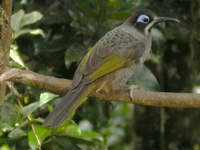


Melidectes, Bismarck also Bismarck Honeyeater Melidectes whitemanensis also Voses whitemanensis Found: New Guinea
Image by: 1) Katerina Tvardikova 2) hbw.com
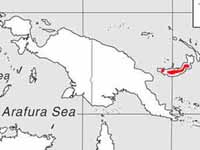

Melidectes, Cinnamon-browed Melidectes ochromelas Found: New Guinea
Image by: 1) Katerina Tvardikova 2) xitek.com


Melidectes, Huon Melidectes foersteri Found: Papua New Guinea
The Huon Melidectes is found only in a small region of northeat Papua New Guinea.
Image by: 1) Katerina Tvardikova
Melidectes, Long-bearded Melidectes princeps Found: New Guinea
The Long-bearded Melidectes has black plumage; orange skin behind eye; long white beard.
Image by: 1) KaterinaTvardikova 2) ilblogsonoio.com

Melidectes, Ornate Melidectes torquatus Found: New Guinea
The male Ornate Meldectes has grayish-brown upperparts; mainly black-brown head, neck; merging to black-brown with brownish mottling on hind-neck; oragne-yellow orbital skin; white fore-neck; black breast-band.
Image by: 1) Katerina Tvardikova 2) David Cook

Melidectes, Short-bearded Melidectes nouhuysi Found: New Guinea
Image by: 1) Katerina Tvardikova 2) Josep del Hoyo


Melidectes, Sooty Melidectes fuscus Found: New Guinea
The Sooty Melidectes has mainly sooty black plumage; whitish eye-arc.
Image by: 1, 2, 3) Katerina Tvardikova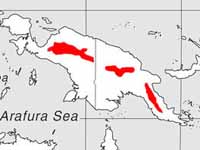


Melidectes, Vegelkop Melidectes leucostephes Found: New Guinea
The Vegelkop Melidectes has mainly dark brown plumage; white forehead; red streaked lower nape; bluish bare orbital skin; dark cinnamon under-tail.
Image by: 1) Lars Petersson
Melidectes, Yellow-browed Melidectes rufocrissalis Found: New Guinea
The Yellow-browed Melidectes has mainly black pluamge; lighter underparts; white orbital patch; then yellow arc above orbital patch.
Image by: 1) Katerina Tvardikova 2) Nigel Voaden 3) Jerry Oldenettel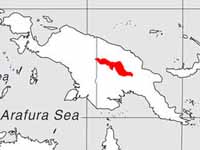


Genus Melilestes - 1 species
Honeyeater,_Long-billed Melilestes megarhynchus Found: New Guinea
The Long-billed Honeyeater has a very long down-curved bill; mainly grayish-brown plumage; dull olive-brown rear flanks; reddish-orange eye.
Image by: 1, 3, 4) Katerina Tvardikova 2) Joseph Smit 



Genus Meliphaga
These honeyeaters are found mainly in New Guinea, also in Australia and Indonesia.
Honeyeater,_Elegant Meliphaga cinereifrons Found: New Guinea
Image by: 1) BJ_Coates
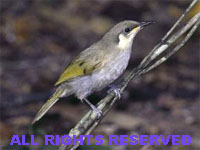
Honeyeater,_Forest Meliphaga montana Found: New Guinea
The Forest Honeyeater has dusky-olive upperparts; blackish lores;yellow or creamy gape; whitish ear covert; grayish underparts.
Image by: 1, 2, 3) Katerina Tvardikova


Honeyeater,_Graceful Meliphaga gracilis Found: Australia, New Guinea
The Graceful Honeyeater has olive upperparts; grayish-olive chin, throat; pale yellow ear coverts; yellow gape; pale olive-gray underparts.
Image by: 1) Katerina Tvardikova 2) JJ Harrison 3) Mike's_Birds


Honeyeater,_Kimberley Meliphaga fordiana Found: northern Australia
The Kimberley Honeyeater has a white line under the eye.
Similar to: White-lined Honeyeater. The Kimberley Honeyeater has been considered a subspecies of the White-lined Honeyeater. Their songs are different.
Image by: 1) Henry Cook 2) George_ChapmanSimilar to: White-lined Honeyeater. The Kimberley Honeyeater has been considered a subspecies of the White-lined Honeyeater. Their songs are different.


Honeyeater,_Lewin's Meliphaga lewinii Found: Australia
The Lewin's Honeyeater mainly greenish-gray plumage; yellow cresent-shaped ear covert; pale yellow gape. black bill.
Image by: 1, 3) David Cook - Rocky Hall, NSW, Australia 2) Glen
Fergus - Tweed Valley,
New South Wales
4) Aviceda - Kobble Creek, SE 5) Lip Kee 
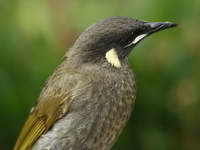
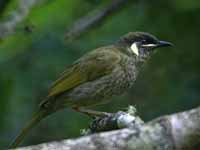


Honeyeater,_Mimic Meliphaga analoga Found: New Guinea
The Mimic Honeyeater has brownish-olive upperparts; brown crown; blackish lores; pale yellow ear coverts; yellow gape; dark brown wing coverts; pale gray underparts.
Image by: 1, 2) Katerina Tvardikova 3) Roland Speck


Honeyeater,_Puff-backed Meliphaga aruensis Found: New Guinea
The Puff-backed Honeyeater has olive-brown to grayish-olive upperparts; deeper olive crown; yellow ear-coverts; pale underparts.
Image by: 1) Katerina Tvardikova 2) hbw.com

Honeyeater,_Scrub Meliphaga albonotata Found: New Guinea
The Scrub Honeyeater has grayish-olive upperparts; blackish lores; bright yellow or orange-yellow gape; white ear covert; lignt grayish underparts.
Image by: 1, 2) Katerina Tvardikova

Honeyeater,_Streak-breasted Meliphaga reticulata Found: Indonesia, East Timor
The Streak-breasted Honeyeater has grayish-olive upperparts; streaked underparts.
Image by: 1) Tom Martin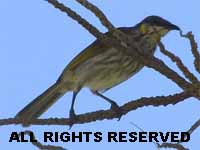
Honeyeater,_Tagula Meliphaga vicina Found: New Guinea
Image by: 1) Katerina Tvardikova 2) hbw.com


Honeyeater,_White-lined Meliphaga albilineata Found: northern Australia
The White-lined Honeyeater has a white line under the eye.
Similar to: Kimberley Honeyeater. The Kimberley Honeyeater has been considered a subspecies of the White-lined Honeyeater. Their songs are different.
Image by: 1) Dave Curtis 2) NieminskiSimilar to: Kimberley Honeyeater. The Kimberley Honeyeater has been considered a subspecies of the White-lined Honeyeater. Their songs are different.


Honeyeater,_Yellow-gaped Meliphaga flavirictus Found: New Guinea
The Yellow-gaped Honeyeater has grayish-olive upperparts; yellowish-white ear-coverts; bright yellow gape;
Image by: 1) Katerina Tvardikova 2) hbw.com

Honeyeater,_Yellow-spotted Meliphaga notata Found: Australia
The Yellow-spotted Honeyeater has olive-brown upperparts; olive-gray underparts; bright yellow patches on head; brown eyes, bill, legs.
Image by: 1) JJ Harrison 2) Francesco Veronesi 3) Brian_McCauley 4) Jeff_Bendon



Meliphaga, Mountain also Mountain Honeyeater Meliphaga orientalis Found: New Guinea
The Mountain Meliphaga has grayish-olive upperparts; forehead darker; pale ear coverts; orange-yellow gape.
Image by: 1, 2) Katerina Tvardikova
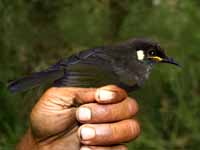
Meliphaga, Spot-breasted also Mottle-breasted Honeyeater Meliphaga mimikae Found: New Guinea
The Spot-breasted Meliphaga has grayish-olive to brownish-olive upperparts; yellowiah lower ear-coverts; blackish lores; olive-gray underparts
Image by: 1) Katerina Tvardikova 2) Cathy Liies

Genus Melipotes
These honeyeaters are found in New Guinea
Honeyeater,_Arfak Melipotes gymnops Found: New Guinea
Image by: 1) Joseph Smit

Honeyeater,_Foja also Wattled Smoky Honeyeater Melipotes carolae Found: New Guinea
The Wattled Smoky Honeyeater has sooty-gray plumage; black bill; reddish-orange facial skin and wattl.e
Image by: 1) Katerina Tvardikova 2) Post of Indonesia 3) Tim Laman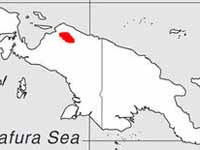


Honeyeater,_Smoky also Common Smoky Honeyeater Melipotes fumigatus Found: New Guinea
Image by: 1, 3) Katerina Tvardikova 2) Mark Sharper 4) Brendan_Ryan



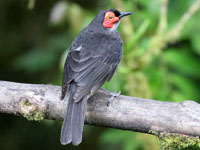
Honeyeater,_Spangled Melipotes ater Found: New Guinea
The Spangled Honeyeater has mainly satin-black plumage with white spots on underparts; bright yellow facial skin and wattles.
Image by: 1) Katerina Tvardikova 2) hbw.com 3) Charles_Davies


Genus Oreornis - 1 species
Honeyeater,_Orange-cheeked Oreornis chrysogenys Found: New Guinea
Image by: 1) Katerina Tvardikova 2) Bram Demeulemeester


Genus Ptiloprora
Honeyeater,_Black-backed also Gray-streaked Honeyeater Ptiloprora perstriata Found: New Guinea
The Black-backed Honeyeater has mainly blackish-brown plumage with with streaking; brown head, neck.
Image by: 1, 2) Katerina Tvardikova 3) Jerry_Oldenettel


Honeyeater,_Leaden Ptiloprora plumbea Found: New Guinea
The Leaden Honeyeater has leaden-gray upperparts with blackish-brown streaking; browner upper-wing, upper-tail; pale gray underparts.
Image by: 1) Katerina Tvardikova 2) Dale Zimmerman

Honeyeater,_Mayr's Ptiloprora mayri Found: New Guinea
Image by: 1) Katerina Tvardikova 2) hbw.com


Honeyeater,_Olive-streaked also Yellowish-streaked Honeyeater Ptiloprora meekiana Found: New Guinea
The Olive-streaked Honeyeater has yellowish-olive upperparts with blackish-olive streaking; blackish-brown upper-wing, upper-tail; pale yellowish-olive underparts with dusky-olive streaking.
Image by: 1) Katerina Tvardikova 2) hbw.com

Honeyeater,_Rufous-backed Ptiloprora guisei Found: New Guinea
The Rufous-backed Honeyeater has blackish-brown upperparts mottled with rufous-brown on mantle; black head and hind-neck with grayish-olive streaking; pale underparts with rufous-blackish streaking.
Image by: 1, 2) Katerina Tvardikova 3) Jerry Oldenettel


Honeyeater,_Rufous-sided Ptiloprora erythropleura Found: New Guinea
The Rufous-sided Honeyeater has blackish-brown upperparts with olive-gray streaking; pale gray underparts; chestnut-brown flanks.
Image by: 1) Katerina Tvardikova 2) hbw.com

Genus Pycnopygius
These honeyeaters are only found in New Guinea
Honeyeater,_Marbled Pycnopygius cinereus Found: New Guinea
The Marbled Honeyeater dark brown upperparts; blackish-brown head; partial pale area around eye; brownish-gray underparts with marbling; brown iris.
Image by: 1, 3) Katerina Tvardikova 2) Joseph Smit 4) Jerry_Oldennettel.



Honeyeater,_Plain Pycnopygius ixoides Found: New Guinea
The Plain Honeyeater has olive-brown upperparts; gray underparts.
Image by: 1) Katerina Tvardikova 2) Jerry Oldenettel

Honeyeater,_Streak-headed Pycnopygius stictocephalus Found: New Guinea
The Streak-headed Honeyeater has dark brown upperparts; blackish-brown head with faint pale streaking; whitish malar; blackish-brown throat; buff brown underparts.
Image by: 1) Katerina Tvardikova 2) hbw.com 3) Jerry Oldenettel


Genus Timeliopsis
Straightbill, Olive Timeliopsis fulvigula Found: New Guinea
The Olive Straightbill has olive-gray plumage; paler underparts; brownish tinge on crown; orange to red-brown eyes.
Image by: 1, 2, 3) Katerina Tvardikova

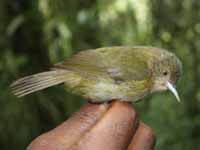
Straightbill, Tawny Timeliopsis griseigula Found: New Guinea
The Tawny Straightbill has olive-brown upperparts; rufous tinge on uppertail paler rufous underparts; reddish eye; pink legs;.
Image by: 1) Katerina Tvardikova 2) B J Coates
